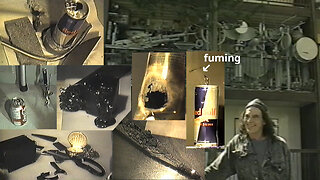Premium Only Content

Cell Structure and Organelles of Animal and Plant Cells
In this video I go over the typical cell structures of animal and plant cells as well as the many organelles that comprise them. Both cells contain a nucleus with most of the organism's genome, besides the mitochondrial DNA in animals and plastid DNA in plants. Plant cells differ from animal cells mainly by having photosynthetic organelles called chloroplasts as well as a large vacuole or fluid containing structure within the plant cell.
Time stamps:
- Cell Structure: 0:00
- Structure of an animal cell showing organelles: 3:45
- (1) Nucleolus: Largest structure in the nucleus, produces ribosomes: 4:09
- (2) Nucleus: contains all of a cell's genome except for mitochondrial DNA (and plastid DNA in plants): 6:38
- (3) Ribosome: Synthesizes protein from messenger RNA (mRNA): 7:37
- (4) Vesicle: Structure consisting of liquid or cytoplasm enclosed by a lipid bilayer: 11:47
- (5) Rough endoplasmic reticulum (RER): Synthesizes lipids such as cholesterol and contains ribosomes: 12:43
- (6) Golgi apparatus or body: Packages proteins into vesicles inside the cell before they are sent to their destination: 13:58
- (7) Cytoskeleton: Network of interlinking protein filaments inside the cytoplasm of all cells: 15:13
- (8) Smooth endoplasmic reticulum (SER): Synthesizes of lipids such as cholesterol, produces steroid hormones, does not contain ribosomes, also does detoxification: 21:34
- (9) Mitochondrion: Generates adenosine triphosphate (ATP) for chemical energy, and has its own genome (mitogenome): 23:05
- (10) Vacuole: Filled with water containing inorganic and organic molecules such as enzymes in solution and sometimes engulfed solids: 25:56
- (11) Cytosol: Solution of many types of molecules dissolved in water and takes up 30% of the cytoplasm by volume: 27:29
- (12) Lysosome: Spherical organelle that contains enzymes that can break down many kinds of biomolecules: 30:45
- (13) Centriole: Cylindrical organelle composed of tubulin, which is typically made up of 9 sets of short microtubule triplets: 34:15
- (14) Cell membrane (or plasma / cytoplasmic membrane): Separates and protects interior of the cell from the outside environment: 42:04
- Many biomolecules (proteins, nucleic acids) within the cytoplasm of a cell: 49:39
- Plant cells have additional organelles such as chloroplasts and a large vacuole: 50:40
- Plant cell wall is an extra layer surrounding some types of cells, just outside the cell membrane: 55:46
- Plants are mainly multicellular and photosynthetic eukaryote organisms of the kingdom Plantae: 56:31
- Photosynthesis converts light energy into chemical energy which can then be used in cellular respiration to fuel the organism's metabolic activities: 1:02:28
- Chloroplasts conduct photosynthesis in which the pigment chlorophyll captures the energy from sunlight, converts, and stores it as ATP and NADPH molecules: 1:03:16
Full video below:
- #MESScience 3: Overview of Biology: https://youtu.be/WX_qzT0nZFY
- HIVE video notes: https://peakd.com/hive-128780/@mes/messcience-3-overview-of-biology
- Video sections playlist: https://www.youtube.com/playlist?list=PLai3U8-WIK0FYO6bxFbBAtVJ9sDOJnH72
- #MESScience playlist: https://www.youtube.com/playlist?list=PLai3U8-WIK0FjJpwnxwdrOR7L8Ul8VZoZ .
------------------------------------------------------
Become a MES Super Fan! https://www.youtube.com/channel/UCUUBq1GPBvvGNz7dpgO14Ow/join
DONATE! ʕ •ᴥ•ʔ https://mes.fm/donate
SUBSCRIBE via EMAIL: https://mes.fm/subscribe
MES Links: https://mes.fm/links
MES Truth: https://mes.fm/truth
Official Website: https://MES.fm
Hive: https://peakd.com/@mes
Email me: contact@mes.fm
Free Calculators: https://mes.fm/calculators
BMI Calculator: https://bmicalculator.mes.fm
Grade Calculator: https://gradecalculator.mes.fm
Mortgage Calculator: https://mortgagecalculator.mes.fm
Percentage Calculator: https://percentagecalculator.mes.fm
Free Online Tools: https://mes.fm/tools
iPhone and Android Apps: https://mes.fm/mobile-apps
-
 5:42:01
5:42:01
Math Easy Solutions
4 days agoUnedited Hutchison Effect: 5 Hours of Rare 2006 Footage
1573 -
 4:31
4:31
CoachTY
1 day ago $28.15 earnedCOINBASE AND DESCI !!!!
184K11 -
 10:02
10:02
MichaelBisping
1 day agoBISPING: "Was FURY ROBBED?!" | Oleksandr Usyk vs Tyson Fury 2 INSTANT REACTION
104K14 -
 8:08
8:08
Guns & Gadgets 2nd Amendment News
2 days ago16 States Join Forces To Sue Firearm Manufacturers Out of Business - 1st Target = GLOCK
126K91 -
 10:17
10:17
Dermatologist Dr. Dustin Portela
2 days ago $19.15 earnedOlay Cleansing Melts: Dermatologist's Honest Review
161K14 -
 1:02:20
1:02:20
Trumpet Daily
2 days ago $50.77 earnedObama’s Fake World Comes Crashing Down - Trumpet Daily | Dec. 20, 2024
116K71 -
 6:29
6:29
BIG NEM
1 day agoCultivating God Mode: Ancient Taoist NoFap Practices
83.8K21 -
 30:53
30:53
Uncommon Sense In Current Times
2 days ago $12.05 earned"Pardon or Peril? How Biden’s Clemency Actions Could Backfire"
93.9K10 -
 40:01
40:01
CarlCrusher
1 day agoSkinwalker Encounters in the Haunted Canyons of Magic Mesa - ep 4
85.5K10 -
 59:44
59:44
PMG
2 days ago $11.54 earned"BETRAYAL - Johnson's New Spending Bill EXPANDS COVID Plandemic Powers"
84.2K52